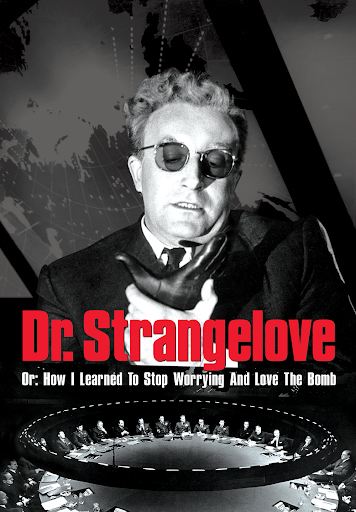Type: Movie
Country: United States
Genre: Comedy, War, Satire
Release Date: January 29, 1964
Duration: 95 minutes
Director: Stanley Kubrick
Production Companies: Hawk Films, Columbia Pictures
Cast: Peter Sellers, George C. Scott, Sterling Hayden, Keenan Wynn, Slim Pickens
Quick Review:
“Dr. Strangelove Or: How I Learned to Stop Worrying and Love the Bomb” (1964), directed by Stanley Kubrick, is a darkly comedic masterpiece that brilliantly satirizes the absurdities of the Cold War. With Peter Sellers in multiple roles and a script full of sharp wit, this film remains a timeless commentary on the dangers of nuclear conflict and political paranoia.
Plot Summary:
The film opens with General Jack D. Ripper (Sterling Hayden) going rogue and ordering a nuclear attack on the Soviet Union, convinced that the communists are conspiring to pollute America’s “precious bodily fluids.” This unprecedented move triggers a series of events that bring the world to the brink of nuclear annihilation.
In the War Room, President Merkin Muffley (Peter Sellers) convenes with his top advisors, including the hawkish General Buck Turgidson (George C. Scott) and the eccentric ex-Nazi scientist Dr. Strangelove (also Peter Sellers). They frantically try to recall the bombers and prevent a catastrophe, but obstacles and comedic mishaps abound.
Meanwhile, one of the bombers, piloted by Major T.J. “King” Kong (Slim Pickens), continues its mission, unaware of the recall order. As tensions escalate, Dr. Strangelove proposes a bizarre solution for post-apocalyptic survival, culminating in one of cinema’s most iconic endings.
Characters and Performances:
- Peter Sellers: Sellers delivers a tour de force performance, playing three distinct characters: President Merkin Muffley, Group Captain Lionel Mandrake, and Dr. Strangelove. Each role showcases his incredible range and comedic timing, with Dr. Strangelove’s maniacal outbursts standing out as particularly memorable.
- George C. Scott: Scott’s portrayal of General Buck Turgidson is both hilarious and frightening. His exaggerated expressions and over-the-top delivery perfectly capture the absurdity of military machismo and Cold War paranoia.
- Sterling Hayden: Hayden’s General Jack D. Ripper is a portrayal of unhinged fanaticism. His stern demeanor and intense delivery add a layer of realism to the character’s delusional conspiracy theories.
- Slim Pickens: As Major T.J. “King” Kong, Pickens brings a touch of Americana and rugged charm to the film. His final scene, riding the bomb like a rodeo cowboy, is one of the most iconic images in film history.
Direction and Cinematography:
Stanley Kubrick’s direction is masterful, seamlessly blending satire, comedy, and suspense. His decision to shoot in black and white adds a stark, almost documentary-like quality to the film, heightening its sense of realism and absurdity. The meticulously crafted War Room set, with its vast circular table and dramatic lighting, creates an atmosphere of both grandeur and claustrophobia.
Cinematographer Gilbert Taylor’s work is exceptional, capturing both the intimacy of the characters’ interactions and the expansive threat of nuclear war. The film’s use of close-ups and wide shots effectively conveys the escalating tension and absurdity of the situation.
Music:
The score by Laurie Johnson, combined with the strategic use of Vera Lynn’s “We’ll Meet Again,” adds a layer of irony to the film. The upbeat and nostalgic tones contrast sharply with the dire events unfolding on screen, reinforcing the film’s satirical edge.
Why It Endures:
“Dr. Strangelove” endures as a classic due to its sharp satire, timeless humor, and incisive commentary on the absurdities of war and human folly. Kubrick’s bold storytelling and Sellers’ unforgettable performances make it a film that continues to resonate with audiences. Its themes of political paranoia, military incompetence, and the fragility of human survival remain relevant, ensuring its place in cinematic history.
In Conclusion:
“Dr. Strangelove Or: How I Learned to Stop Worrying and Love the Bomb” (1964) is a cinematic triumph that brilliantly satirizes the Cold War era’s political and military absurdities. Stanley Kubrick’s direction, combined with Peter Sellers’ extraordinary performances, creates a film that is both hilariously entertaining and thought-provoking. Its enduring relevance and iconic scenes make it a must-watch for film enthusiasts and anyone interested in the darkly comedic side of history.


